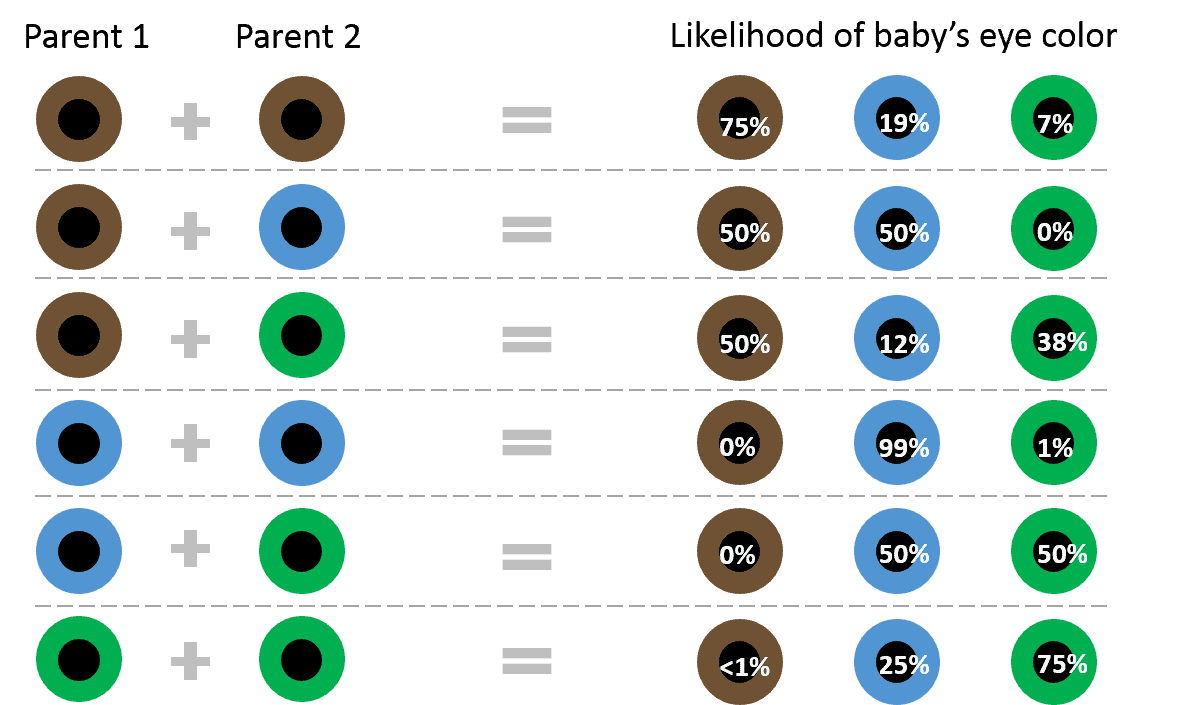
It is said that the eyes are the doorway to the heart; a reflection of our inner self and emotions with countless poets, writers, and artists praising this unique quality. Whether or not this is the case, eyes are deeply fascinating and have been so since time immemorial. But for all this, they’d certainly be far less interesting, and perhaps even frightening, if they weren’t colored.
Actually, all the magic happens within the colored part of the eye: the iris.
Contents
What gives eyes their color
The iris color is determined by the amount of melanin pigmentation. The more pigment there is, the darker the iris will be. Blue, gray, and green eyes are lighter because there is less melanin inside the iris.
By far, the most common eye color in the world is brown, with over 55% of the population falling into this category. Depending on where a person is born, eye color demographics can vary wildly. For instance, nearly all persons of African and Asian ancestry have brown eyes. It’s believed up to 10,000 years ago, all humans had brown eyes only. Then a mutation turned off the pigmentation on the front of the iris.
Hazel eyes are similar to brown eyes, the distinction being these are lighter. A defining trait of hazel eyes is their multi-coloured appearance that can vary from copper to green depending on the lighting. Hazel eyes have a higher concentration of melanin around the iris’ border. Estimates suggest 5 to 8 percent of the world’s population is hazle-eyed (both green and brown).
The next most common eye colors are blue, gray, and green in this order. It’s commonly quoted that only 2% of the world’s population has green eyes.
There are also so-called ‘amber’ eyes. which are even rarer than green eyes. Amber eyes or ‘wolf eyes’ as they’re sometimes called are completely solid and have a strong yellowish, golden, or russet and coppery tint. They can also contain a small amount of gold-ish gray. It’s not clear how amber eyes form but some suggest it’s due to the increased presence of a pigment called lipochrome (also known as pheomelanin).
Lastly, people with albinism, a condition that causes a complete lack of or very low levels of pigment in the skin, hair, and eyes, sometimes appear to have violet or red eyes. Because albino people essentially lack pigment in the iris, light simply bounces off the back of the eye. Albino eyes may appear red because the light reflected first off blood vessels at the back of the retina. This is the same reason why you sometimes appear red-eyed in photos. The eyes can appear violet in certain lighting conditions when the red color mixes with the bluish color resulting from light-scattering effects — basically for the same reason why the sky is blue.
The table below shows how melanin content influences eye color.
Iris pigmentation and coloring
|
Eye color
|
Melanin Presence (front layer)
|
Melanin Presence (back layer)
|
Dominant Pigment Type
|
|---|---|---|---|
|
Brown
|
Heavy
|
Normal
|
Eumelanin
|
|
Blue
|
Light
|
Normal
|
Eumelanin
|
|
Gray
|
Even less than blue
|
Normal
|
Eumelanin
|
|
Green
|
More than blue eyes, less than brown
|
Normal
|
Pheomelanin
|
|
Hazel
|
More than green, less than brown
|
Normal
|
Pheomelanin and Eumelanin
|
|
Amber
|
Heavy
|
Normal
|
Pheomelanin
|
|
Red or Violet
|
None or extremely little
|
None or extremely little
|
n/a
|
Besides making eyes colored, the pigment melanin also serves the vital function of protecting them from the sun’s UV rays. It follows that darker eyes, which have the most melanin, are less sensitive to the sun’s harmful rays than lighter eyes like blue.
When we come into this world, our eyes are blue or almost colorless. This is true for all babies, no matter their ancestry. In time, the concentration of melanin increases and by age three, the eyes will have darkened to their true, final resting color. Or almost final. Much later in life, our eyes can change color once more. Disease and trauma can also inflict changes in iris coloring. More on that later.
How eye color is inherited

Note that this chart only takes into account parents’ eye colors. Because it only factors in the phenotype (i.e. what color the eyes appear) and not the genes themselves, it is not going to be 100% accurate in every case. Credit: SittingAround.
If both parents have blue eyes, there’s a good chance their offspring has blue eyes as well. It follows that iris coloring is governed by genetics. However, a baby’s eye color doesn’t come out as a blend of the parent’s eye, as if you mixed paint. Up until not too long ago, even doctors used to think used to think that eye color was determined by a single gene and followed a simple inheritance pattern in which brown eyes were dominant to blue eyes. The thinking was that if two parents both had blue eyes, they couldn’t make a baby with brown eyes. Imagine what sort of problems this caused back at home. Alas, this is wrong.
Instead, many various possibilities exist since each parent has two pairs of genes on each chromosome. In other words, eye color is a polygenic trait, meaning it is determined by multiple genes.
The eye color genes
Among the genes that affect eye color, OCA2 and HERC2 stand out. Both of these genes are found in the human chromosome 15. The OCA2 gene produces a cell membrane transporter of tyrosine, a precursor of melanin. Mutations in OCA2 result in oculocutaneous albinism, a condition associated with vision problems such as reduced sharpness and increased sensitivity to light. HERC2 regulates the OCA2 genes’ expression. In the European population, a common polymorphism in HERC2 gene is responsible for the blue eye phenotype. A person who has two copies of C allele at HERC2 rs1293832 will likely have blue eyes while homozygous TT predicts likely brown eyes.
Eye color inheritance
| rs12913832 | TT ALLELE | CC ALLELE | TC ALLELE |
|---|---|---|---|
| Likelihood of eye color for people of European descent | 85% chance of brown eyes; 14% chance of green eyes; 1% chance of blue eyes. |
72% chance of blue eyes; 27% chance of green eyes; 1% chance of brown eyes. |
56% chance of brown eyes; 37% chance of green eyes; 7% chance of blue eyes. |
Several other genes play smaller roles in determining eye color. Some of these genes are also involved in skin and hair coloring. Genes with reported roles in eye color include ASIP, IRF4, SLC24A4, SLC24A5, SLC45A2, TPCN2, TYR, and TYRP1. The effects of these genes likely combine with those of OCA2 and HERC2 to produce a continuum of eye colors in different people.
Nowadays, many DNA tests are reliable enough to determine a person’s eye color from a hair sample alone, some with over 90% accuracy. Such analyses are now becoming more and more common in the field of forensic investigations.
How eye color changes during lifetime
The iris, the colored bit of the eyes, is essentially a muscle. Its role is to control pupil size so we can see better under varying lighting conditions. When there’s dim light, the pupils enlarges and, conversely, grows smaller in bright lighting. Pupils also change size depending on focused objects. For instance, reading a book requires your pupils to shrink in order to focus on the near objects, i.e. words inked on the paper.
When the pupil’s size changes, the melanin pigment is compressed or spread apart, slightly changing the eye color. The effect is minuscule but it’s there.
The iris is a muscle that expands and contracts to control pupil size. The pupil enlarges in dimmer lighting and grows smaller in brighter lighting. The pupil also shrinks when you focus on near objects, such as a book you are reading.
When the pupil size changes, the pigments in the iris can become compressed or spread apart, changing the eye color a bit. Some have suggested that mood can also change eye color. While it’s true certain emotions like anger or love can influence pupil size, the iris doesn’t really change color. When a person’s eyes have red, dilated blood vessels from anger, his eyes may appear to be greener because of the contrast, that’s all.
Eye color can permanently change over the course of one’s life, though. For 10 to 15 percent of the Caucasian population, iris color changes with age. For instance, hazel eyes can get dark with age. And if such a change in eye color happens fast and dramatically, like from brown to green or from blue to brown, this may be a sign of concern making a doctor’s appointment urgently required. Eye color changes can be a warning sign of certain diseases, such as Fuch’s heterochromic iridocyclitis, Horner’s syndrome or pigmentary glaucoma.
The eye color infographic


